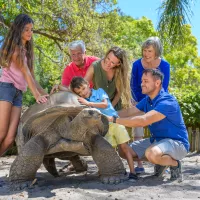Alligators: The Low-Down on These Low-Lying Creatures
If you want to ensure you see reptilian basking beauties, Sarasota can make that happen, be it in their natural habitat, at a protected enclosure, or in your arms.
If you want to ensure you see reptilian basking beauties, Sarasota can make that happen, be it in their natural habitat, at a protected enclosure, or in your arms.
“Attention students, the school is going on a limited lockdown due to an alligator traveling on campus.” This is no social media post, showing up alongside pictures of alligators climbing fences, lumbering through parking lots, and popping up on Ring cameras. This was my son’s middle school last year. His campus boasts a pond where science experiments are often conducted and it does, in fact, home a gator. It’s not surprising, as one should assume that any fresh body of water in Florida could potentially home an American alligator such as this education-interrupter. Which means, if you’re hoping to spot these basking beauties – or a hundred – Sarasota can make that happen.
Where can you see them?
With their smooth scutes, sleek swimming, and stunning smiles, alligators are rather beautiful creatures. At a safe distance, their minimal movement allows for maximum observation. It’s as though they are begging you to gaze into their triple-lidded eyes and fall madly in love, be it in their natural habitat, at a protected enclosure, or in your arms.

Sarasota Jungle Gardens: Between the reptile interaction where you can (safely) hold an alligator for an epic photo op and the interactive reptile shows where herpetologists educate and entertain, it’s easy to get your alligator fix at Jungle Gardens. A feeding pool houses baby gators waiting for you to give them a bite, while Dominic the massive bull lingers silently in his pond.
Smuggler’s Cove Adventure Golf: Home of the pirate putt-putt, but also of feeding live American alligators. Fear not – your fingers are safe. Feeding happens at a safe distance utilizing fishing poles that you dangle over these curious critters’ craniums. The moment when those jaws chomp your food off is quite a thrill! Located just blocks from Jungle Gardens.
Myakka River State Park: To see these crocodilians in their natural habitat, Myakka is your place. Shortly upon entering, pull over along the bridge on Park Drive and you’re already at good odds of spotting a gator at a distance. If you hope to get a bit closer, mosey over to Upper Myakka Lake, where your kayak and the reptile can move side by side. Myakka Outdoors offers a shady pontoon ride where experts will keep you safe and point out the silent swimmers for you. Hungry for even more? Venture deeper into Myakka and you’ll encounter Deep Hole, a 200-foot wide sinkhole and home to myriad (we’re talking 100+) alligators.

Mote Marine Aquarium: Look eye to eye with their alligator and caimans at their The Teeth Beneath exhibit. Mote calls them “old timers” (they have been on Earth for 80 million years!) and graced them with the appropriate names of Rose, Dorothy, Sophia, and Blanche. With a focus on education about conservation and identification of the various crocodilians, Mote successfully allows its visitors to marvel at these roommates closely and safely.
Bonus: You can adopt an alligator! See their website for details.
Mixon Fruit Farms: A ride on the tram tour brings you to their Florida Wildlife Care & Education Center, where the expert team of Wildlife Inc rehabilitates local injured and orphaned animals to be released in the wild, including alligators (many “removed” alligators are euthanized; Wildlife Inc does not partake in this practice). Learn more from these local animal enthusiasts, touch an alligator’s armor, and, if you’re lucky, give them a feed. Caretaker Damen shares a special bond with the larger reptiles, the likes of which I’ve never seen.
Ponds, creeks, and rivers: With an estimated 1.3 million alligators in Florida, according to the Florida Fish and Wildlife Conservation, you have good odds of seeing one if you keep your eyes peeled. My family has one we have lovingly named Poppy living in the Creek behind our house where we paddleboard, my mechanic has one in the pond next to his shop, and my mother-in-law frequents a golf course where a gator frequently ambles from one water source to another.

What if you don’t want to see an alligator?
As American alligators live in fresh and brackish water, you are clear of them at the beach. Luckily, Sarasota has plenty of those!
What should you do if you encounter an alligator?
Do not feed it. Alligators are afraid of humans and will generally keep their distance. But, like with a puppy or a toddler, stranger danger often disappears when a treat is offered. Attacks are rare, but don’t risk it.
Do not approach an alligator. Give it space and skedaddle. See you later, alligator.

![Boat parking at The Crow’s Nest in Venice [Photo: Lauren Jackson]](/sites/default/files/styles/popular_stories_teaser/public/2023-import/The-Crow%2527s-Nest-cropped__OPT.jpg.webp?itok=ycs37M-O)


